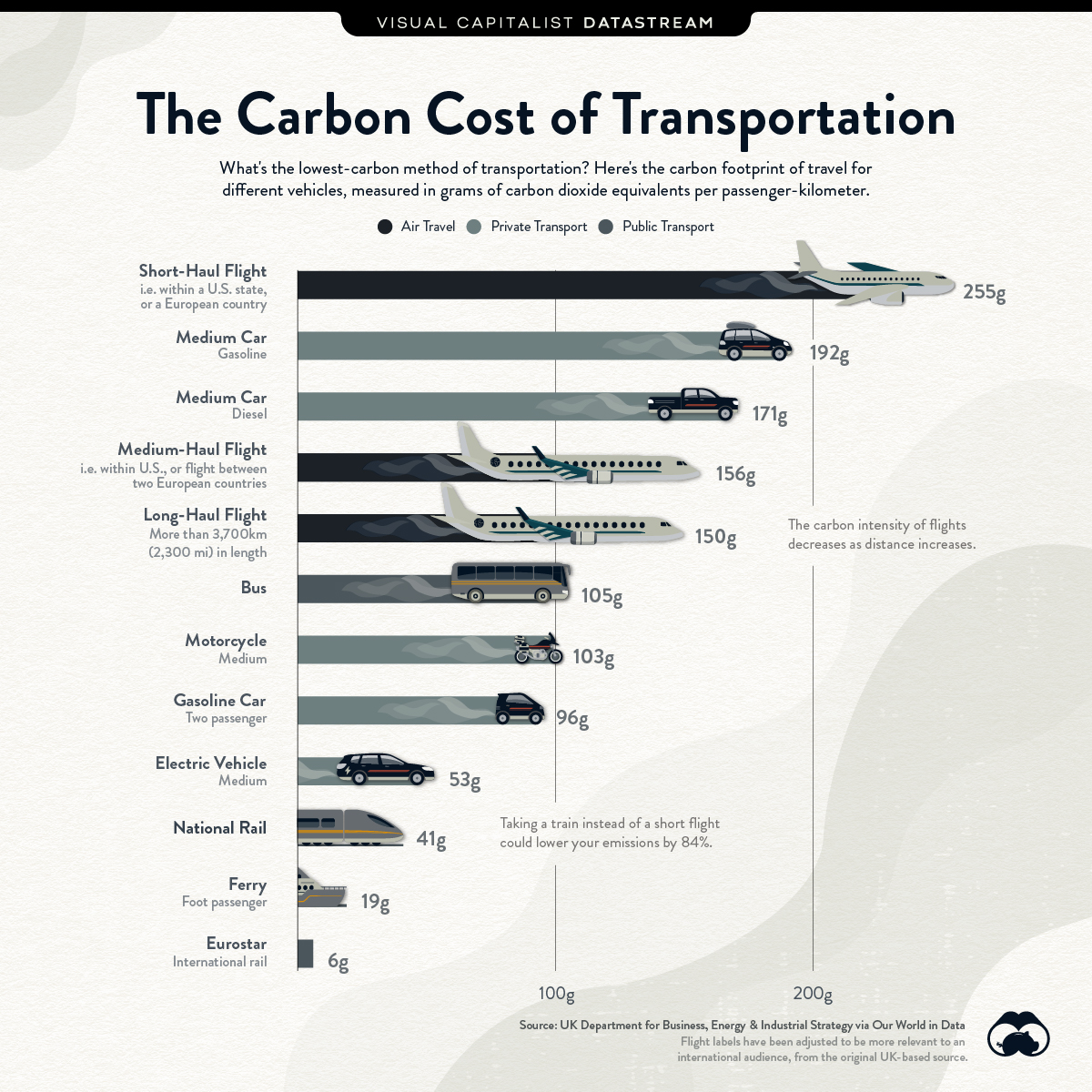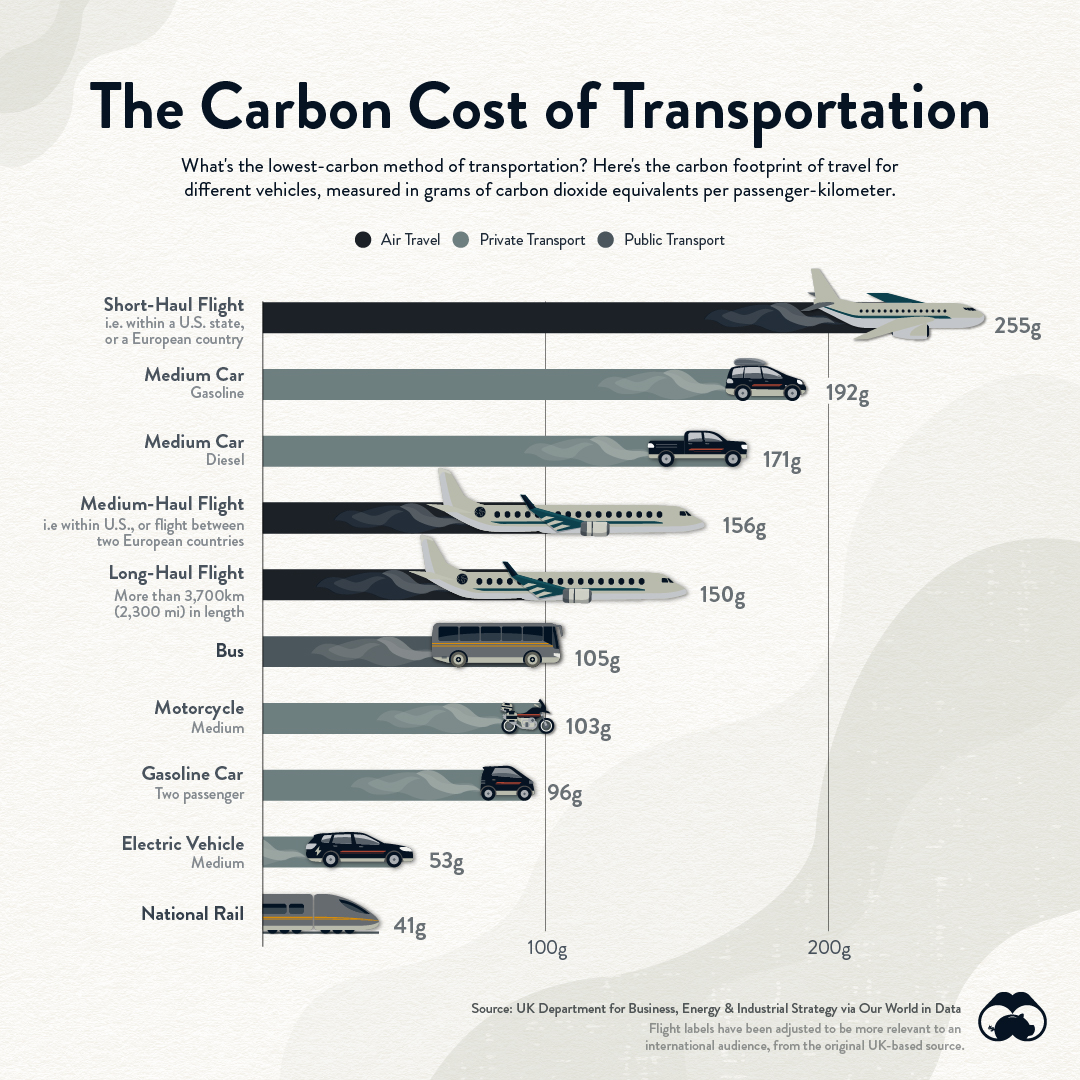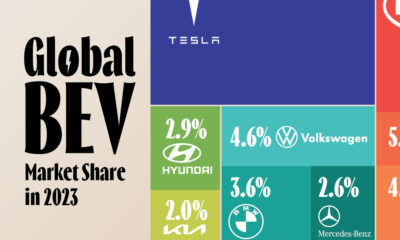Datastream
Comparing the Carbon Footprint of Transportation Options

The Briefing
- Flying domestically and driving alone are the most carbon-intensive travel methods
- Taking a train instead of a short flight could reduce your emissions by 84%
The Carbon Footprint of Transportation
As concern about climate change has grown, individuals are becoming increasingly conscious of their impact on the environment.
Transportation emissions often make up the largest portion of our individual carbon footprints. For that reason, evaluating transport options is a natural place to start, whether it is for a daily commute or a leisure trip abroad.
So, what’s the most eco-friendly way to go from one place to another?
The above infographic charts the carbon footprint of transportation per passenger-kilometer for different vehicles based on data from the UK Government’s methodology paper for greenhouse gas reporting.
Editor’s note: Because the original labels in the study are very UK-specific, we have changed the copy of some of the labels to better suit an international audience.
Planes, Trains and Automobiles: How Carbon Footprints Compare
The carbon footprint of transportation is measured in grams of carbon dioxide (CO2) equivalents emitted per person to travel one kilometer. This includes both carbon dioxide and other greenhouse gases.
Here’s how the carbon cost of travel compares for different means of transport:
| Means of Transport | CO2 equivalent emissions per passenger km |
|---|---|
| Short Flight ✈️ | 255g |
| Medium Car (Gasoline) 🚗 | 192g |
| Medium Car (Diesel) 🚗 | 171g |
| Medium Flight ✈️ | 156g |
| Long Flight ✈️ | 150g |
| Bus 🚌 | 105g |
| Medium Motorcycle 🏍 | 103g |
| Gasoline Car (Two Passenger) 🚘 | 96g |
| Medium Electric Vehicle 🚙 | 53g |
| National Rail 🚂 | 41g |
| Ferry ⛴ | 19g |
| Eurostar (International Rail) 🚞 | 6g |
Flying on a short flight or driving alone are the most carbon-intensive travel methods. However, adding one more passenger to your car ends up cutting the emissions in half, making driving more efficient.
Specifically, it’s worth breaking down categories of flights more, as their emissions depend greatly on their route length:
- Short Flights: For example, domestic flights within a European country, or flights within a U.S. state have the highest individual carbon footprint.
- Medium Flights: For example, international travel within Europe, or between U.S. states, have a significantly lower carbon footprint per person.
- Long Flights: Flights over 3,700 km (2,300 mi), about the distance from Los Angeles to New York, have the lowest carbon footprint per person.
Why are longer flights far more eco-friendly than short-range flights? It’s because take-off uses much more energy than the ‘cruise’ phase of a flight. For short flights, the efficient cruise phase is relatively short-lived.
Shrinking Your Travel Footprint
As the world works to mitigate the impact of climate change, people may want to identify and potentially reduce their daily carbon footprint. And choosing your method of transportation is one way to do so.
Of course, walking, biking, or running are the lowest-carbon ways to go from one place to another. But car-sharing can also reduce emissions, as can switching to electric vehicles or public transport.
Over medium-to-long distances, trains are the most eco-friendly option, and for short-range domestic travel, driving is better than taking a flight. But as some countries are bigger than others, always consider the total distance you need to travel, and the breadth of options you have available.
Where does this data come from?
Source: UK Department for Business, Energy & Industrial Strategy, Our World in Data
Datastream
Can You Calculate Your Daily Carbon Footprint?
Discover how the average person’s carbon footprint impacts the environment and learn how carbon credits can offset your carbon footprint.

The Briefing
- A person’s carbon footprint is substantial, with activities such as food consumption creating as much as 4,500 g of CO₂ emissions daily.
- By purchasing carbon credits from Carbon Streaming Corporation, you can offset your own emissions and fund positive climate action.
Your Everyday Carbon Footprint
While many large businesses and countries have committed to net-zero goals, it is essential to acknowledge that your everyday activities also contribute to global emissions.
In this graphic, sponsored by Carbon Streaming Corporation, we will explore how the choices we make and the products we use have a profound impact on our carbon footprint.
Carbon Emissions by Activity
Here are some of the daily activities and products of the average person and their carbon footprint, according to Clever Carbon.
| Household Activities & Products | CO2 Emissions (g) |
|---|---|
| 💡 Standard Light Bulb (100 watts, four hours) | 172 g |
| 📱 Mobile Phone Use (195 minutes per day)* | 189 g |
| 👕 Washing Machine (0.63 kWh) | 275 g |
| 🔥 Electric Oven (1.56 kWh) | 675 g |
| ♨️ Tumble Dryer (2.5 kWh) | 1,000 g |
| 🧻 Toilet Roll (2 ply) | 1,300 g |
| 🚿 Hot Shower (10 mins) | 2,000 g |
| 🚙 Daily Commute (one hour, by car) | 3,360 g |
| 🍽️ Average Daily Food Consumption (three meals of 600 calories) | 4,500 g |
| *Phone use based on yearly use of 69kg per the source, Reboxed | |
Your choice of transportation plays a crucial role in determining your carbon footprint. For instance, a 15 km daily commute to work on public transport generates an average of 1,464 g of CO₂ emissions. Compared to 3,360 g—twice the volume for a journey the same length by car.
By opting for more sustainable modes of transport, such as cycling, walking, or public transportation, you can significantly reduce your carbon footprint.
Addressing Your Carbon Footprint
One way to compensate for your emissions is by purchasing high-quality carbon credits.
Carbon credits are used to help fund projects that avoid, reduce or remove CO₂ emissions. This includes nature-based solutions such as reforestation and improved forest management, or technology-based solutions such as the production of biochar and carbon capture and storage (CCS).
While carbon credits offer a potential solution for individuals to help reduce global emissions, public awareness remains a significant challenge. A BCG-Patch survey revealed that only 34% of U.S. consumers are familiar with carbon credits, and only 3% have purchased them in the past.
About Carbon Streaming
By financing the creation or expansion of carbon projects, Carbon Streaming Corporation secures the rights to future carbon credits generated by these sustainable projects. You can then purchase these carbon credits to help fund climate solutions around the world and compensate for your own emissions.
Ready to get involved?
>> Learn more about purchasing carbon credits at Carbon Streaming
-

 Green1 week ago
Green1 week agoRanked: The Countries With the Most Air Pollution in 2023
-

 Misc2 weeks ago
Misc2 weeks agoAlmost Every EV Stock is Down After Q1 2024
-

 AI2 weeks ago
AI2 weeks agoThe Stock Performance of U.S. Chipmakers So Far in 2024
-

 Markets2 weeks ago
Markets2 weeks agoCharted: Big Four Market Share by S&P 500 Audits
-

 Real Estate2 weeks ago
Real Estate2 weeks agoRanked: The Most Valuable Housing Markets in America
-

 Money2 weeks ago
Money2 weeks agoWhich States Have the Highest Minimum Wage in America?
-

 AI2 weeks ago
AI2 weeks agoRanked: Semiconductor Companies by Industry Revenue Share
-

 Travel2 weeks ago
Travel2 weeks agoRanked: The World’s Top Flight Routes, by Revenue














